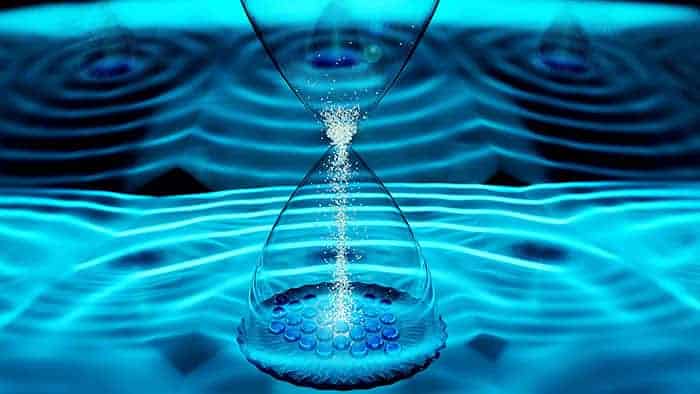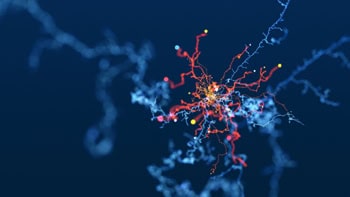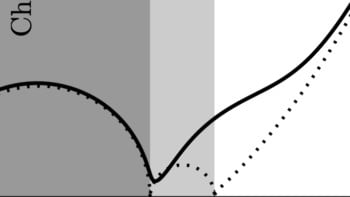
When time crystals were first proposed in 2012 by physicist Frank Wilczek they seemed like an exotic consequence of quantum mechanics in systems of many interacting particles. Wilczek argued that such systems broke symmetry in time, changing so as to return periodically to the same state just as ordinary crystals exhibit periodicity in space.
Subsequent experimental work has found that quantum time crystals can exist in systems maintained out of equilibrium by some driving force. Now Norman Yao of the University of California at Berkeley and colleagues suggest that time crystals can arise without the need for quantum physics at all. They argue that purely classical systems of oscillators such as coupled pendulums could have the same time-crystal order as their quantum counterparts. What is more, time crystals could be made experimentally, and might even exist in nature.
A non-equilibrium (or discrete) time crystal responds to a periodic driving force by showing some kind of oscillation in time with a period different to – generally some whole multiple of – the driver. In the 1830s Michael Faraday showed in theory that a class of periodically driven oscillators now known as parametric resonators can undergo “period-doubling”, meaning that they oscillate at half the driving frequency. This is precisely the kind of so-called subharmonic response that characterizes time crystals.
Sparking discussions
This long history has sparked discussions of whether purely classical systems might show time-crystal behavior. Last year, a team from the Swiss Federal Institute of Technology (ETH) in Zurich showed experimentally that two coupled oscillating strings displayed period-doubling. They pointed out that there is a close analogy between this behaviour and that seen in quantum many-body time crystals.
But a true time crystal needs something more, says Yao’s team. Discrete time crystals (DTCs) are “open” systems that are kept out of equilibrium by some energy input from the environment. In general, this input causes the system to slowly heat up. Over time its temperature would rise without limit, eventually “melting” the time crystal so the periodic order disappears.
In quantum DTCs this heating is prevented by “many-body localization” (MBL), whereby disorder in the arrangement of component parts inhibits energy exchange between their energy levels, preventing the spread and equilibration of heat.
Heat bath
There is no known classical analogue of MBL and so it was not clear if classical DTCs would be stable against heating. One way to avoid heating classically is by dissipation: coupling the system to a heat bath, for example via friction for a mechanically oscillating system.
This is what happens in Faraday’s parametric resonators and the ETH vibrating strings. But Yao and colleagues point out that this adds noise to the system, and a crucial question is whether the time-crystal oscillations can withstand it. This because true time crystals must also be stable against perturbations and noise in the driving – just as a space crystal is resilient to fluctuations.
The researchers have now identified a simple classical system that could have DTC behaviour in the presence of noise. It is a series of pendulums or oscillators, arranged in a row and connected to one another as if by springs.
Slightly nonlinear
The oscillators must be slightly nonlinear, which means that they do not undergo perfectly harmonic oscillation. Meanwhile, the dissipative coupling to the environment could be achieved by viscous friction
“We argue that classical DTCs could exist in principle even if there’s noise”, says Yao’s Berkeley colleague Michael Zaletel. “That hadn’t been shown before.”
The team show that this classical DTC will crystallize from a time-symmetric (non-periodic) state as the noise is reduced and the strength of the coupling between pendulums is increased, in an abrupt phase transition. It is closely analogous to the way a space crystal freezes from a liquid as it is cooled (lowering the noise) and/or the intermolecular forces get stronger. In computer simulations, the researchers see their period-doubled time crystal “nucleating” out of the time-symmetric state like a crystal growing from a seed.

‘Time crystals’ built in the lab
This behaviour does not persist indefinitely, however. At any finite temperature, it will decay very slowly and eventually “melt”. There is some quantity (noise or temperature) that controls the lifetime of the TC. “We don’t have a true classical DTC”, Yao says. “Ours dies at very long times; we think”. But the system looks like one unless you watch it long enough. The researchers call such a system an “activated time crystal”.
The surface waves studied by Faraday and the mechanical model studied experimentally by the ETH team, they say, were probably like this – but because the influence of thermal noise is so tiny for macroscopic oscillators, the DTC would have decayed only extremely slowly, making it last much longer than the experimental timescale.
Not a new phase of matter
Because this new time crystal is not infinitely long-lived, says Vedika Khemani at Stanford University in California, it cannot be considered a new phase of matter. “As far as we know, MBL quantum systems are still the only examples of many-body time-crystals”, she says.
Yao and colleagues argue, however, that an indefinitely persistent classical DTC might be possible if the oscillators or pendulums are coupled together in a more complicated way. That suggestion stems from their analysis of a different kind of system called a cellular automaton, made from many identical components whose states depend on those of their neighbours. Yao and Zaletel admit they have no rigorous proof of this yet – and that making a mechanical system governed by such rules could be “insanely complicated.”

In search of time crystals
Yao and colleagues believe the system they have simulated might occur in the real systems such as coupled oscillating Josephson junctions, or quasi-classical excitations of electrons called charge-density waves. “Experiments on charge-density waves were done in the 1980s that showed what looks to the eye like period doubling”, says Zaletel. “It would be very interesting to go back to these experiments and check.”
The researchers speculate that systems like theirs in which time-crystal oscillations exist for long if not infinite times might even be found in living systems such as colonies of interacting cells. Such periodicity at a subharmonic frequency determined by the internal dynamics of the system might be useful in biology, they say – and their relatively simple prescription for an activated DTC could be the preferred one. “It’s definitely useful to get oscillations in biology”, says Zaletel, “and it’s usually enough to have them for finite but long times.”
The research is described in Nature Physics.



